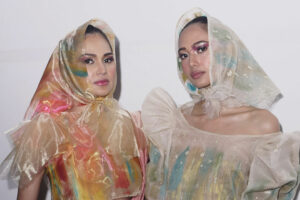
The great terno experiment
A NATIONAL terno-making convention, organized by clothing conglomerate Bench and the Cultural Center of the Philippines (CCP), will once again culminate in a celebration of the Philippine dress, the terno, in a gala on Jan. 26, 2025, called Ternocon.
This year’s edition is the fourth, and its ongoing workshops are guided by designers Ezra Santos, Lulu Tan-Gan, and Rhett Eala. Like last year, designer Inno Sotto will serve as chief mentor.
The second mentoring workshop was launched via a press conference and fashion show in the Bench Tower in BGC on Oct. 16. It included a short preview of terno designs by the mentors, along with last year’s gold medalist, Yssa Inumerable. This year’s contestants — Windell Madis, Geomarie Hernandez, Johnoel Marin, Patrick Lazol, Jericho Gonzales, Irene Subang, Bryan Peralta, Peach Garde, Ram Silva, Lexter Badana, Jared Palmejar, Monina Gatan, Xioti Chiu, and Jema Gamer — were also introduced.
Ms. Inumerable showed off striking modern interpretations of the terno’s less formal sister, the balintawak, one in a pink hue and the other in blue, while Mr. Eala showed the distinct aesthetic elements of the terno in bold golden yellow and hot pink. Ms. Tan-Gan showed contemporary frills and used sheer fabric for a babydoll twist on the classic terno, and then Mr. Santos showed stylized patterned white gowns putting a medieval-like spin on Philippine dress.
INSPIRED BY ARTThe terno is a dress that must be preserved and promoted, according to Ternocon’s artistic director Ricardo Eric Cruz. At the first mentoring workshop held in June in Baguio City, the finalists brushed up on the history and parameters of terno, balintawak, and kimona designs, including knitting and fabric manipulation and technology.
“Ternocon was conceived primarily out of a need to further promote the importance and relevance of the Filipino dress — the terno — with its very distinct stiffened butterfly sleeves, through a convention and competition,” Mr. Cruz said in an opening speech.
He later told BusinessWorld that the event is “an avenue to connect the skills learned through the workshops, so that participating designers can inspire and motivate others to create ternos at par with today’s techniques.”
This year’s edition requires the finalists to create a capsule three-piece collection consisting of a formal terno with a pañuelo (a light shawl), a formal balintawak with an alampay (over the shoulder kerchief) and tapis (a small overskirt), and a formal kimona (a pull-over blouse) with an alampay and a patadyong (a tube-like wraparound skirt).
Their creations must draw inspiration from 20th century Philippine contemporary art. This is why prints of works by Ang Kiukok, Abdulmari Imao, Lao Lianben, and Anita Magsaysay-Ho were on display at the press launch.
Kaye C. Tinga, current CCP president, praised the innovations made by Ternocon participants over the years. “The creativity of our young designers, all while remaining deeply rooted in Filipino design and craftsmanship, has been nothing short of inspiring,” she said in a speech.
“It’s this blend of innovation and tradition that makes Ternocon truly special,” she added. — Brontë H. Lacsamana


